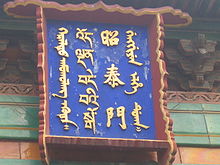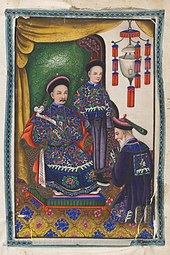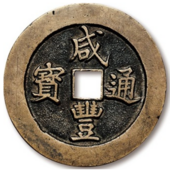Qing dynasty
This article may be readable prose size was 13,950 words. . (March 2024) |
Great Qing | |||||||||||||||||||||
|---|---|---|---|---|---|---|---|---|---|---|---|---|---|---|---|---|---|---|---|---|---|
| 1644[1][2]–1912 | |||||||||||||||||||||
|
Xuantong Emperor | |||||||||||||||||||||
Zaifeng , Prince Chun | |||||||||||||||||||||
| Prime Minister | |||||||||||||||||||||
• 1911 | Yikuang, Prince Qing | ||||||||||||||||||||
• 1911–1912 | Yuan Shikai | ||||||||||||||||||||
| Legislature |
| ||||||||||||||||||||
| 12 February 1912 | |||||||||||||||||||||
| Area | |||||||||||||||||||||
| 1700[6] | 8,800,000 km2 (3,400,000 sq mi) | ||||||||||||||||||||
| 1790[6] | 14,700,000 km2 (5,700,000 sq mi) | ||||||||||||||||||||
| 1860[6] | 13,400,000 km2 (5,200,000 sq mi) | ||||||||||||||||||||
| 1908[7] | 11,350,000 km2 (4,380,000 sq mi) | ||||||||||||||||||||
| Currency | |||||||||||||||||||||
| |||||||||||||||||||||
| Qing dynasty | |||||
|---|---|---|---|---|---|
| Chinese name | |||||
Mongolian Cyrillic | Дайчин Улс | ||||
| Mongolian script |
| ||||
| |||||
| Manchu name | |||||
| Manchu script |
| ||||
| Abkai | Daiqing gurun | ||||
| Möllendorff | Daicing gurun | ||||
| Part of a series on the |
| History of China |
|---|
| History of Manchuria |
|---|
 |
The Qing dynasty (
The
In 1900 anti-foreign "
Names
Hong Taiji proclaimed the Great Qing dynasty in 1636.
After conquering China proper, the Manchus identified their state as "China", equivalently as 中國; Zhōngguó; 'middle kingdom' in Chinese and Dulimbai Gurun in Manchu.[f] The emperors equated the lands of the Qing state (including, among other areas, present-day Northeast China, Xinjiang, Mongolia, and Tibet) as "China" in both the Chinese and Manchu languages, defining China as a multi-ethnic state, and rejecting the idea that only Han areas were properly part of "China". The government used "China" and "Qing" interchangeably to refer to their state in official documents,[23] including the Chinese-language versions of treaties and maps of the world.[24] The term 'Chinese people' (中國人; Zhōngguórén; Manchu: ᡩᡠᠯᡳᠮᠪᠠᡳ
ᡤᡠᡵᡠᠨ ᡳ
ᠨᡳᠶᠠᠯᠮᠠ Dulimbai gurun-i niyalma) referred to all the Han, Manchu, and Mongol subjects of the Qing Empire.[25] When the Qing conquered Dzungaria in 1759, it proclaimed within a Manchu-language memorial that the new land had been absorbed into "China".[26]: 77 The Qing government expounded an ideology that it was bringing the "outer" non-Han peoples—such as various populations of Mongolians, as well as the Tibetans—together with the "inner" Han Chinese into "one family", united within the Qing state. Phraseology like 中外一家; Zhōngwài yījiā and 內外一家; nèiwài yījiā—both translatable as 'home and abroad as one family'—was employed to convey this idea of Qing-mediated trans-cultural unity.[26]: 76–77
In English, the Qing dynasty is sometimes known as the "Manchu dynasty".[27]
History
Formation
The Qing dynasty was founded not by the Han people, who constitute the majority of the Chinese population, but by the Manchus, descendants of a sedentary farming people known as the Jurchens, a Tungusic people who lived around the region now comprising the Chinese provinces of Jilin and Heilongjiang.[28] The Manchus are sometimes mistaken for a nomadic people,[29] which they were not.[30][31]
Nurhaci
The early form of the Manchu state was founded by Nurhaci, the chieftain of a minor Jurchen tribe – the Aisin-Gioro – in Jianzhou in the early 17th century. Nurhaci may have spent time in a Han household in his youth, and became fluent in Chinese and Mongolian languages and read the Chinese novels Romance of the Three Kingdoms and Water Margin.[32][33] As a vassal of the Ming emperors, he officially considered himself a guardian of the Ming border and a local representative of the Ming dynasty.[15] Nurhaci embarked on an intertribal feud in 1582 that escalated into a campaign to unify the nearby tribes. By 1616, however, he had sufficiently consolidated Jianzhou so as to be able to proclaim himself Khan of the Later Jin dynasty in reference to the previous Jurchen-ruled Jin dynasty.[34]
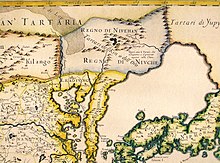
Two years later, Nurhaci announced the "Seven Grievances" and openly renounced the sovereignty of Ming overlordship in order to complete the unification of those Jurchen tribes still allied with the Ming emperor. After a series of successful battles, he relocated his capital from Hetu Ala to successively bigger captured Ming cities in Liaodong: first Liaoyang in 1621, then Mukden (Shenyang) in 1625.[34] Furthermore, the Khorchin proved a useful ally in the war, lending the Jurchens their expertise as cavalry archers. To guarantee this new alliance, Nurhaci initiated a policy of inter-marriages between the Jurchen and Khorchin nobilities, while those who resisted were met with military action. This is a typical example of Nurhaci's initiatives that eventually became official Qing government policy. During most of the Qing period, the Mongols gave military assistance to the Manchus.[35]
Hong Taiji
Nurhaci died in 1626, and was succeeded by his eighth son,

Meanwhile, Hong Taiji set up a rudimentary bureaucratic system based on the Ming model. He established six boards or executive level ministries in 1631 to oversee finance, personnel, rites, military, punishments, and public works. However, these administrative organs had very little role initially, and it was not until the eve of completing the conquest ten years later that they fulfilled their government roles.[38]
Hong Taiji staffed his bureaucracy with many Han Chinese, including newly surrendered Ming officials, but ensured Manchu dominance by an ethnic quota for top appointments. Hong Taiji's reign also saw a fundamental change of policy towards his Han Chinese subjects. Nurhaci had treated Han in Liaodong according to how much grain they had: those with less than 5 to 7 sin were treated badly, while those with more were rewarded with property. Due to a Han revolt in 1623, Nurhaci turned against them and enacted discriminatory policies and killings against them. He ordered that Han who assimilated to the Jurchen (in Jilin) before 1619 be treated equally with Jurchens, not like the conquered Han in Liaodong. Hong Taiji recognized the need to attract Han Chinese, explaining to reluctant Manchus why he needed to treat the Ming defector General Hong Chengchou leniently.[39] Hong Taiji incorporated Han into the Jurchen "nation" as full (if not first-class) citizens, obligated to provide military service. By 1648, less than one-sixth of the bannermen were of Manchu ancestry.[40]
Claiming the Mandate of Heaven
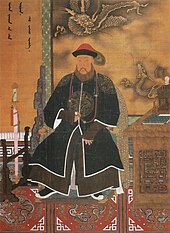
Hong Taiji died suddenly in September 1643. As the Jurchens had traditionally "elected" their leader through a council of nobles, the Qing state did not have a clear succession system. The leading contenders for power were Hong Taiji's oldest son
Meanwhile, Ming government officials fought against each other, against fiscal collapse, and against a series of peasant rebellions. They were unable to capitalise on the Manchu succession dispute and the presence of a minor as emperor. In April 1644, the capital, Beijing, was sacked by a coalition of rebel forces led by Li Zicheng, a former minor Ming official, who established a short-lived Shun dynasty. The last Ming ruler, the Chongzhen Emperor, committed suicide when the city fell to the rebels, marking the official end of the dynasty.
Li Zicheng then led rebel forces numbering some 200,000[41] to confront Wu Sangui, at Shanhai Pass, a key pass of the Great Wall, which defended the capital. Wu Sangui, caught between a Chinese rebel army twice his size and a foreign enemy he had fought for years, cast his lot with the familiar Manchus. Wu Sangui may have been influenced by Li Zicheng's mistreatment of wealthy and cultured officials, including Li's own family; it was said that Li took Wu's concubine Chen Yuanyuan for himself. Wu and Dorgon allied in the name of avenging the death of the Chongzhen Emperor. Together, the two former enemies met and defeated Li Zicheng's rebel forces in battle on May 27, 1644.[42]
The newly allied armies captured Beijing on 6 June. The
The Qing had taken shrewd advantage of Ming civilian government discrimination against the military and encouraged the Ming military to defect by spreading the message that the Manchus valued their skills.[43] Banners made up of Han Chinese who defected before 1644 were classed among the Eight Banners, giving them social and legal privileges. Han defectors swelled the ranks of the Eight Banners so greatly that ethnic Manchus became a minority – only 16% in 1648, with Han Bannermen dominating at 75% and Mongol Bannermen making up the rest.[44] Gunpowder weapons like muskets and artillery were wielded by the Chinese Banners.[45] Normally, Han Chinese defector troops were deployed as the vanguard, while Manchu Bannermen were used predominantly for quick strikes with maximum impact, so as to minimize ethnic Manchu losses.[46]
This multi-ethnic force conquered Ming China for the Qing.[47] The three Liaodong Han Bannermen officers who played key roles in the conquest of southern China were Shang Kexi, Geng Zhongming, and Kong Youde, who governed southern China autonomously as viceroys for the Qing after the conquest.[48] Han Chinese Bannermen made up the majority of governors in the early Qing, stabilizing Qing rule.[49] To promote ethnic harmony, a 1648 decree allowed Han Chinese civilian men to marry Manchu women from the Banners with the permission of the Board of Revenue if they were registered daughters of officials or commoners, or with the permission of their banner company captain if they were unregistered commoners. Later in the dynasty the policies allowing intermarriage were done away with.[50]
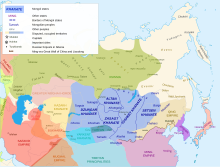
The first seven years of the young Shunzhi Emperor's reign were dominated by Dorgon's regency. Because of his own political insecurity, Dorgon followed Hong Taiji's example by ruling in the name of the emperor at the expense of rival Manchu princes, many of whom he demoted or imprisoned. Dorgon's precedents and example cast a long shadow. First, the Manchus had entered "South of the Wall" because Dorgon had responded decisively to Wu Sangui's appeal, then, instead of sacking Beijing as the rebels had done, Dorgon insisted, over the protests of other Manchu princes, on making it the dynastic capital and reappointing most Ming officials. No major Chinese dynasty had directly taken over its immediate predecessor's capital, but keeping the Ming capital and bureaucracy intact helped quickly stabilize the regime and sped up the conquest of the rest of the country. Dorgon then drastically reduced the influence of the eunuchs and directed Manchu women not to bind their feet in the Chinese style.[51]
However, not all of Dorgon's policies were equally popular or as easy to implement. The controversial July 1645 edict (the "
On 31 December 1650, Dorgon died suddenly, marking the start of the Shunzhi Emperor's personal rule. Because the emperor was only 12 years old at that time, most decisions were made on his behalf by his mother,
The Manchus sent Han Bannermen to fight against Koxinga's Ming loyalists in Fujian.[59] They removed the population from coastal areas in order to deprive Koxinga's Ming loyalists of resources. This led to a misunderstanding that Manchus were "afraid of water". Han Bannermen carried out the fighting and killing, casting doubt on the claim that fear of the water led to the coastal evacuation and ban on maritime activities.[60] Even though a poem refers to the soldiers carrying out massacres in Fujian as "barbarians", both Han Green Standard Army and Han Bannermen were involved and carried out the worst slaughter.[61] 400,000 Green Standard Army soldiers were used against the Three Feudatories in addition to the 200,000 Bannermen.[62]
Kangxi Emperor's reign and consolidation
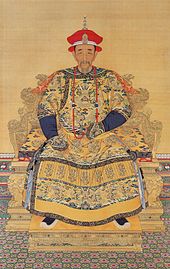
The sixty-one year reign of the
The second major source of stability was the
Kangxi's reign started when he was seven years old. To prevent a repeat of Dorgon's monopolizing of power, on his deathbed his father hastily appointed four regents who were not closely related to the imperial family and had no claim to the throne. However, through chance and machination, Oboi, the most junior of the four, gradually achieved such dominance as to be a potential threat. In 1669 Kangxi, through trickery, disarmed and imprisoned Oboi – a significant victory for a fifteen-year-old emperor.
The young emperor faced challenges in maintaining control of his kingdom, as well. Three Ming generals singled out for their contributions to the establishment of the dynasty had been granted governorships in Southern China. They became increasingly autonomous, leading to the Revolt of the Three Feudatories, which lasted for eight years. Kangxi was able to unify his forces for a counterattack led by a new generation of Manchu generals. By 1681, the Qing government had established control over a ravaged southern China, which took several decades to recover.[72]
To extend and consolidate the dynasty's control in Central Asia, the Kangxi Emperor personally led a series of military campaigns against the
Reigns of the Yongzheng and Qianlong emperors
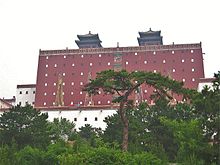
The reigns of the Yongzheng Emperor (r. 1723–1735) and his son, the Qianlong Emperor (r. 1735–1796), marked the height of Qing power. Yet, as the historian Jonathan Spence puts it, the empire by the end of the Qianlong reign was "like the sun at midday". In the midst of "many glories", he writes, "signs of decay and even collapse were becoming apparent".[75]
After the death of the
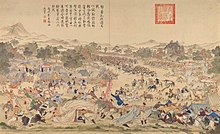
Yongzheng also inherited diplomatic and strategic problems. A team made up entirely of Manchus drew up the Treaty of Kyakhta (1727) to solidify the diplomatic understanding with Russia. In exchange for territory and trading rights, the Qing would have a free hand in dealing with the situation in Mongolia. Yongzheng then turned to that situation, where the Zunghars threatened to re-emerge, and to the southwest, where local Miao chieftains resisted Qing expansion. These campaigns drained the treasury but established the emperor's control of the military and military finance.[81]
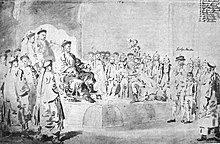
When Yongzheng Emperor died in 1735 his son Prince Bao (寶親王) became the Qianlong Emperor. Qianlong personally led the

Population was stagnant for the first half of the 17th century due to civil wars and epidemics, but prosperity and internal stability gradually reversed this trend. The Qianlong Emperor bemoaned the situation by remarking, "The population continues to grow, but the land does not." The introduction of new crops from the Americas such as the potato and peanut allowed an improved food supply as well, so that the total population of China during the 18th century ballooned from 100 million to 300 million people. Soon farmers were forced to work ever-smaller holdings more intensely. The only remaining part of the empire that had arable farmland was Manchuria, where the provinces of Jilin and Heilongjiang had been walled off as a Manchu homeland. Despite prohibitions, by the 18th century Han Chinese streamed into Manchuria, both illegally and legally, over the Great Wall and Willow Palisade.
In 1796, open rebellion broke out among followers of the White Lotus Society, who blamed Qing officials, saying "the officials have forced the people to rebel." Officials in other parts of the country were also blamed for corruption, failing to keep the famine relief granaries full, poor maintenance of roads and waterworks, and bureaucratic factionalism. There soon followed uprisings of "new sect" Muslims against local Muslim officials, and Miao tribesmen in southwest China. The White Lotus Rebellion continued for eight years, until 1804, when badly run, corrupt, and brutal campaigns finally ended it.[84]
Rebellion, unrest, and external pressure

At the start of the dynasty, the
However, during the 18th century European empires gradually expanded across the world, as European states developed economies built on maritime trade, colonial extraction, and advances in technology. The dynasty was confronted with
In 1793, the British East India Company, with the support of the British government, sent a
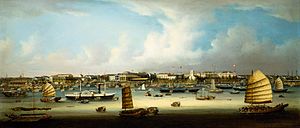
Since China had little demand for European goods, Europe paid in silver for Chinese goods, an imbalance that worried the
The
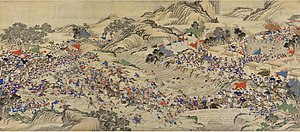
The Western powers, largely unsatisfied with the Treaty of Nanjing, gave grudging support to the Qing government during the Taiping and Nian Rebellions. China's income fell sharply during the wars as vast areas of farmland were destroyed, millions of lives were lost, and countless armies were raised and equipped to fight the rebels. In 1854, Britain tried to re-negotiate the Treaty of Nanjing, inserting clauses allowing British commercial access to Chinese rivers and the creation of a permanent British embassy at Beijing.
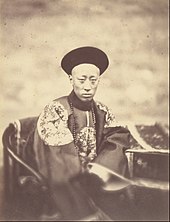
In 1856, Qing authorities, in searching for a pirate, boarded a ship, the Arrow, which the British claimed had been flying the British flag, an incident which led to the Second Opium War. In 1858, facing no other options, the Xianfeng Emperor agreed to the Treaty of Tientsin, which contained clauses deeply insulting to the Chinese, such as a demand that all official Chinese documents be written in English and a proviso granting British warships unlimited access to all navigable Chinese rivers.
Ratification of the treaty in the following year led to a resumption of hostilities. In 1860, with Anglo-French forces marching on Beijing, the emperor and his court fled the capital for the
Self-strengthening and the frustration of reforms
Yet the dynasty rallied. Chinese generals and officials such as Zuo Zongtang led the suppression of rebellions and stood behind the Manchus. When the Tongzhi Emperor came to the throne at the age of five in 1861, these officials rallied around him in what was called the Tongzhi Restoration. Their aim was to adopt Western military technology in order to preserve Confucian values. Zeng Guofan, in alliance with Prince Gong, sponsored the rise of younger officials such as Li Hongzhang, who put the dynasty back on its feet financially and instituted the Self-Strengthening Movement. The reformers then proceeded with institutional reforms, including China's first unified ministry of foreign affairs, the Zongli Yamen; allowing foreign diplomats to reside in the capital; establishment of the Imperial Maritime Customs Service; the formation of modernized armies, such as the Beiyang Army, as well as a navy; and the purchase from Europeans of armament factories.[89]
The dynasty lost control of peripheral territories bit by bit. In return for promises of support against the British and the French, the
In 1884, Qing China obtained concessions in
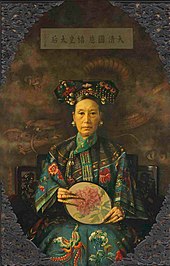
These years saw an evolution in the participation of Empress Dowager Cixi (Wade–Giles: Tz'u-Hsi) in state affairs. She entered the imperial palace in the 1850s as a concubine to the Xianfeng Emperor (r. 1850–1861) and came to power in 1861 after her five-year-old son, the Tongzhi Emperor ascended the throne. She, the Empress Dowager Ci'an (who had been Xianfeng's empress), and Prince Gong (a son of the Daoguang Emperor), staged a coup that ousted several regents for the boy emperor. Between 1861 and 1873, she and Ci'an served as regents, choosing the reign title "Tongzhi" (ruling together). Following the emperor's death in 1875, Cixi's nephew, the Guangxu Emperor, took the throne, in violation of the dynastic custom that the new emperor be of the next generation, and another regency began. In the spring of 1881, Ci'an suddenly died, aged only forty-three, leaving Cixi as sole regent.[93]
From 1889, when Guangxu began to rule in his own right, to 1898, the Empress Dowager lived in semi-retirement, spending the majority of the year at the

In the wake of these external defeats, the Guangxu Emperor initiated the

Drought in North China, combined with the imperialist designs of European powers and the instability of the Qing government, created background conditions for the Boxers. In 1900, local groups of Boxers proclaiming support for the Qing dynasty murdered foreign missionaries and large numbers of Chinese Christians, then converged on Beijing to besiege the Foreign Legation Quarter. A coalition of European, Japanese, and Russian armies (the Eight-Nation Alliance) then entered China without diplomatic notice, much less permission. Cixi declared war on all of these nations, only to lose control of Beijing after a short, but hard-fought campaign. She fled to Xi'an. The victorious allies then enforced their demands on the Qing government, including compensation for their expenses in invading China and execution of complicit officials, via the Boxer Protocol.[95]
Reform, revolution, collapse


The defeat by Japan in 1895 created a sense of crisis which the failure of the 1898 reforms and the disasters of 1900 only exacerbated. Cixi in 1901 moved to mollify the foreign community, called for reform proposals, and initiated a set of "
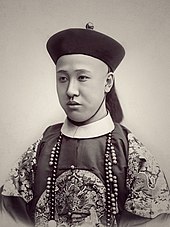
The Guangxu Emperor died on 14 November 1908 and Cixi died the following day. Puyi, the oldest son of Zaifeng, Prince Chun, and nephew to the childless Guangxu Emperor, was appointed successor at the age of two, leaving Zaifeng with the regency. Zaifeng forced Yuan Shikai to resign. The Qing dynasty became a constitutional monarchy on 8 May 1911, when Zaifeng created a "responsible cabinet" led by Yikuang, Prince Qing. However, the cabinet became known as the "royal cabinet" because among the thirteen cabinet members, five were members of the imperial family or Aisin-Gioro relatives.[99]
The
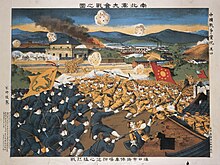
On 12 February 1912, Longyu issued the
Government
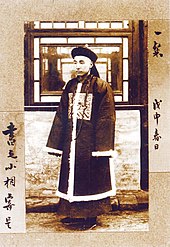
The early Qing emperors adopted the
While the Qing dynasty tried to maintain the traditional tributary system of China, by the 19th century Qing China had become part of a European-style community of sovereign states[103] and established official diplomatic relations with more than twenty countries around the world before its downfall, and since the 1870s it established legations and consulates known as the "Chinese Legation", "Imperial Consulate of China", "Imperial Chinese Consulate (General)" or similar names in seventeen countries, namely the Austria-Hungary, Belgium, Brazil, Cuba, France, Germany, Italy, Japan, Mexico, Netherlands, Panama, Peru, Portugal, Russia, Spain, United Kingdom (or the British Empire) and the United States.
Central government agencies
The formal structure of the Qing government centered on the Emperor as the absolute ruler, who presided over six Boards (Ministries[g]), each headed by two presidents[h] and assisted by four vice presidents.[i] In contrast to the Ming system, however, Qing ethnic policy dictated that appointments were split between Manchu noblemen and Han officials who had passed the highest levels of the state examinations. The Grand Secretariat,[j] which had been an important policy-making body under the Ming, lost its importance during the Qing and evolved into an imperial chancery. The institutions which had been inherited from the Ming formed the core of the Qing "Outer Court", which handled routine matters and was located in the southern part of the Forbidden City.[104]
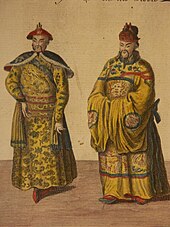
In order not to let the routine administration take over the running of the empire, the Qing emperors made sure that all important matters were decided in the "Inner Court", which was dominated by the imperial family and Manchu nobility and which was located in the northern part of the Forbidden City. The core institution of the inner court was the Grand Council.[k] It emerged in the 1720s under the reign of the Yongzheng Emperor as a body charged with handling Qing military campaigns against the Mongols, but soon took over other military and administrative duties, centralizing authority under the crown.[105] The Grand Councillors[l] served as a sort of privy council to the emperor.
From the early Qing, the central government was characterized by a system of dual appointments by which each position in the central government had a Manchu and a Han Chinese assigned to it. The Han Chinese appointee was required to do the substantive work and the Manchu to ensure Han loyalty to Qing rule.[106]
There was also another government institution called
Administrative divisions


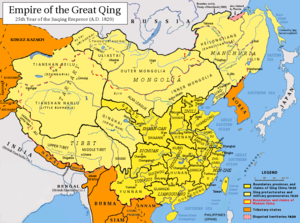
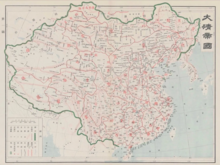
Qing China reached its largest extent during the 18th century, when it ruled China proper (eighteen provinces) as well as the areas of present-day Northeast China, Inner Mongolia, Outer Mongolia, Xinjiang and Tibet, at approximately 13 million km2 in size. There were originally 18 provinces, all of which in China proper, but later this number was increased to 22, with Manchuria and Xinjiang being divided or turned into provinces. Taiwan, originally part of Fujian province, became a province of its own in the 19th century,[111] but was ceded to the Empire of Japan following the First Sino-Japanese War in 1895.[112]
Territorial administration
This section needs additional citations for verification. (March 2022) |
The Qing organization of
By the mid-18th century, the Qing had successfully put outer regions such as Inner and Outer Mongolia, Tibet and Xinjiang under its control. Imperial commissioners and garrisons were sent to Mongolia and Tibet to oversee their affairs. These territories were also under supervision of a central government institution called Lifan Yuan. Qinghai was also put under direct control of the Qing court. Xinjiang, also known as Chinese Turkestan, was subdivided into the regions north and south of the Tian Shan mountains, also known today as Dzungaria and Tarim Basin respectively, but the post of Ili General was established in 1762 to exercise unified military and administrative jurisdiction over both regions. Dzungaria was fully opened to Han migration by the Qianlong Emperor from the beginning. Han migrants were at first forbidden from permanently settling in the Tarim Basin but were the ban was lifted after the invasion by Jahangir Khoja in the 1820s. Likewise, Manchuria was also governed by military generals until its division into provinces, though some areas of Xinjiang and Northeast China were lost to the Russian Empire in the mid-19th century. Manchuria was originally separated from China proper by the Inner Willow Palisade, a ditch and embankment planted with willows intended to restrict the movement of the Han Chinese, as the area was off-limits to civilian Han Chinese until the government started colonizing the area, especially since the 1860s.
With respect to these outer regions, the Qing maintained imperial control, with the emperor acting as Mongol khan, patron of
Society
Population growth and mobility
The population grew in numbers, density, and mobility. The population grew from roughly 150 million in 1700, about what it had been a century before, then doubled over the next century, and reached a height of 450 million on the eve of the Taiping Rebellion in 1850.[116] The spread of New World crops, such as maize, peanuts, sweet potatoes, and potatoes decreased the number of deaths from malnutrition. Diseases such as smallpox were brought under control by an increase in inoculations. In addition, infant deaths were decreased due to improvements in birthing techniques performed by doctors and midwives and an increase in medical books available to the public.[117] Government campaigns decreased the incidence of infanticide. In Europe population growth in this period was greatest in the cities, but in China growth in cities and the lower Yangzi was low. The greatest growth was in the borderlands and the highlands, where farmers could clear large tracts of marshlands and forests.[118]
The population was also remarkably mobile, perhaps more so than at any time in Chinese history. Indeed, the Qing government did far more to encourage mobility than to discourage it. Millions of Han Chinese migrated to
Manchuria, however, was formally closed to Han settlement by the Willow Palisade, with the exception of some bannermen.[119] Nonetheless, by 1780, Han Chinese had become 80% of the population.[120] The relatively low populated territory was vulnerable as the Russian Empire demanded the Amur Annexation annexing Outer Manchuria. In response, the Qing officials such as Tepuqin (特普欽), the Military Governor of Heilongjiang in 1859–1867, made proposals (1860) to open parts of Guandong for Chinese civilian farmer settlers in order to oppose further possible annexations.[121] In the later 19th century, Manchuria was opened up for Han settlers leading to a more extensive migration,[122] which was called Chuang Guandong (simplified Chinese: 闯关东; traditional Chinese: 闖關東) literally "Crashing into Guandong" with Guandong being an older name for Manchuria.[123] At the end of the 19th century and turn of the 20th century, to counteract increasing Russian influence, the Qing Dynasty abolished the existing administrative system in Manchuria and reclassified all immigrants to the region as Han (Chinese) instead of minren (民人, civilians, non-bannermen), while replacing provincial generals with provincial governors. From 1902 to 1911, seventy civil administrations were created due to the increasing population of Manchuria.[124]
Statuses in society
According to statute, Qing society was divided into relatively closed estates, of which in most general terms there were five. Apart from the estates of the officials, the comparatively minuscule aristocracy, and the degree-holding literati, there also existed a major division among ordinary Chinese between commoners and people with inferior status.[125] They were divided into two categories: one of them, the good "commoner" people, the other "mean" people who were seen as debased and servile. The majority of the population belonged to the first category and were described as liangmin, a legal term meaning good people, as opposed to jianmin meaning the mean (or ignoble) people. Qing law explicitly stated that the traditional four occupational groups of scholars, farmers, artisans and merchants were "good", or having a status of commoners. On the other hand, slaves or bondservants, entertainers (including prostitutes and actors), tattooed criminals, and those low-level employees of government officials were the "mean people". Mean people were legally inferior to commoners and suffered unequal treatments, such as being forbidden to take the imperial examination.[126] Furthermore, such people were usually not allowed to marry with free commoners and were even often required to acknowledge their abasement in society through actions such as bowing. However, throughout the Qing dynasty, the emperor and his court, as well as the bureaucracy, worked towards reducing the distinctions between the debased and free but did not completely succeed even at the end of its era in merging the two classifications together.[127]
Qing gentry
Although there had been no powerful hereditary aristocracy since the Song dynasty, the gentry (shenshi), like their British counterparts, enjoyed imperial privileges and managed local affairs. The status of this scholar-official was defined by passing at least the first level of civil service examinations and holding a degree, which qualified him to hold imperial office, although he might not actually do so. The gentry member could legally wear gentry robes and could talk to officials as equals. Informally, the gentry then presided over local society and could use their connections to influence the magistrate, acquire land, and maintain large households. The gentry thus included not only males holding degrees but also their wives and some of their relatives.[128]

The gentry class was divided into groups. Not all who held office were literati, as merchant families could purchase degrees, and not all who passed the exams found employment as officials, since the number of degree-holders was greater than the number of openings. The gentry class also differed in the source and amount of their income. Literati families drew income from landholding, as well as from lending money. Officials drew a salary, which, as the years went by, were less and less adequate, leading to widespread reliance on "squeeze", irrgular payments. Those who prepared for but failed the exams, like those who passed but were not appointed to office, could become tutors or teachers, private secretaries to sitting officials, administrators of guilds or temples, or other positions that required literacy. Others turned to fields such as engineering, medicine, or law, which by the nineteenth century demanded specialized learning. By the nineteenth century, it was no longer shameful to become an author or publisher of fiction.[129]
The Qing gentry were marked as much by their aspiration to a cultured lifestyle as by their legal status. They lived more refined and comfortable lives than the commoners and used sedan-chairs to travel any significant distance. They often showed off their learning by collecting objects such as scholars' stones, porcelain or pieces of art for their beauty, which set them off from less cultivated commoners.[130]
Qing nobility
Family and kinship

By the Qing, the building block of society was patrilineal kinship, that is, the local family lineage with descent through the male line, often translated as "clan". A shift in marital practices, identity and loyalty had begun during the Song dynasty when the civil service examination began to replace nobility and inheritance as a means for gaining status. Instead of intermarrying within aristocratic elites of the same social status, they tended to form marital alliances with nearby families of the same or higher wealth, and established the local people's interests as first and foremost which helped to form intermarried townships.[131] The neo-Confucian ideology, especially the Cheng-Zhu thinking favored by Qing social thought, emphasised patrilineal families and genealogy in society.[132]
The emperors and local officials exhorted families to compile genealogies in order to stabilize local society.[133] The genealogy was placed in the ancestral hall, which served as the lineage's headquarters and a place for annual ancestral sacrifice. A specific Chinese character appeared in the given name of each male of each generation, often well into the future. These lineages claimed to be based on biological descent but when a member of a lineage gained office or became wealthy, he might use considerable creativity in selecting a prestigious figure to be "founding ancestor".[134] Such worship was intended to ensure that the ancestors remain content and benevolent spirits (shen) who would keep watch over and protect the family. Later observers felt that the ancestral cult focused on the family and lineage, rather than on more public matters such as community and nation.[135]
Inner Mongols and Khalkha Mongols in the Qing rarely knew their ancestors beyond four generations and Mongol tribal society was not organized among patrilineal clans, contrary to what was commonly thought, but included unrelated people at the base unit of organization.[136] The Qing tried but failed to promote the Chinese Neo-Confucian ideology of organizing society along patrimonial clans among the Mongols.[137]
Religion
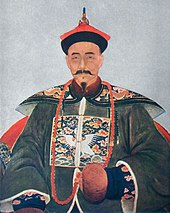
In 1685, the Kangxi emperor legalized private maritime trade along the coast, establishing a series of customs stations in major port cities. The customs station at Canton became by far the most active in foreign trade; by the late Kangxi reign, more than forty mercantile houses specializing in trade with the West had appeared. The Yongzheng emperor made a parent corporation comprising those forty individual houses in 1725 known as the Cohong system. Firmly established by 1757, the Canton Cohong was an association of thirteen business firms that had been awarded exclusive rights to conduct trade with Western merchants in Canton. Until its abolition after the Opium War in 1842, the Canton Cohong system was the only permitted avenue of Western trade into China, and thus became a booming hub of international trade.[135] By the eighteenth century, the most significant export China had was tea. British demand for tea increased exponentially up until they figured out how to grow it for themselves in the hills of northern India in the 1880s. By the end of the eighteenth century, tea exports going through the Canton Cohong system amounted to one-tenth of the revenue from taxes collected from the British and nearly the entire revenue of the British East India Company; in fact, until the early nineteenth century tea comprised ninety percent of exports leaving Canton.[135]
Revenue
The recorded revenues of the central Qing government increased little over the course of the 18th and early 19th century from 36,106,483 taels in 1725 to 43,343,978 taels in 1812 before declining to 38,600,570 taels in 1841, the land tax was the principal source of revenue for the central government with the salt, customs and poll taxes being important secondary sources.[184] Following the Opium wars and the opening of China to foreign trade and the mid-century rebellions, two further important sources of revenue were added: the foreign maritime customs revenue and the likin revenue though only 20% of the likin revenue was actually given by the provinces to Hu Pu (board of revenue) in Beijing the rest remaining in provincial hands, the Hu Pu also managed to raise some miscellaneous taxes and increased the rate of the salt tax these measures doubled revenue by the late 19th century, this however was insufficient for the central government which was facing numerous crises and wars during the period and 9 foreign loans amounting to 40mil taels were contracted by the Qing government prior to 1890.[185]
It was estimated in the 1850s that wages around the capital of Beijing and the Yangtze delta region for a farmer was between 0.99 and 1.02 taels a month assuming every day was worked this would amount to roughly 12 taels a year with over 400,000,000 citizens in 1890 the level of taxation was extremely low.[186]
The Financial Reorganisation bureau of the Dynasty (established in 1909) estimated total revenue to be 292,000,000 taels. H.B. Morse estimated in the early 1900s a total of 284,150,000 taels of which 99,062,000 taels was spent by the Central government, 142,374,000 taels by the provincial governments and the remainder by the local government. In 1911 the Consultative assembly estimated total revenue to be 301,910,297 taels. Included in this figure was over 44,000,000 taels from the Likin of which only 13,000,000 was reported to Beijing.[187]
The Qing government during and following the First Sino-Japanese war increasingly took on loans to meet its expenditure requirements a total of 746,220,453 taels of which slightly over 330,000,000 taels was for Railway construction and the repayment to come from the revenues of the railways themselves thus these loans did not burden the central government finances. A relatively small sum of just over 25,500,000 taels was borrowed for industrial projects, over 5,000,000 taels for Telegraph lines with less than 1,000,000 taels for miscellaneous purposes. The remainder was primarily for the costs of the Sino-Japanese war and the indemnity in the Treaty of Shimonoseki amounting to over 382,000,000 taels.[187]
Taizu noted that these figures for formal taxation only amounted to half of the total taxation and therefore revenue of the government with these surcharges being levied at a local level by local officials who found the level of taxation far too low to support even basic governance, despite the ability to levy surcharges belonging solely to the central government.[188]
Science and technology
Chinese scholars, court academies, and local officials carried on late Ming dynasty strengths in
The Opium Wars, however, demonstrated the power of steam engine and military technology that had only recently been put into practice in the West. During the Self-Strengthening Movement of the 1860s and 1870s Confucian officials in several coastal provinces established an industrial base in military technology. The introduction of railroads into China raised questions that were more political than technological. A British company built the 19 km (12 mi) Shanghai–Woosung line in 1876, obtaining the land under false pretenses, and it was soon torn up. Court officials feared local public opinion and that railways would help invaders, harm farmlands, and obstruct feng shui.[191] To keep development in Chinese hands, the Qing government borrowed 34 billion taels of silver from foreign lenders for railway construction between 1894 and 1911. As late as 1900, only 470 km (292 mi) were in operation. Finally, 8,400 km (5,200 mi) of railway was completed. The British and French after 1905 opened lines to Burma and Vietnam.[192]
Protestant missionaries by the 1830s translated and printed Western science and medical textbooks. The textbooks found homes in the rapidly enlarging network of missionary schools and universities. The textbooks opened learning open possibilities for the small number of Chinese students interested in science, and a very small number interested in technology. After 1900, Japan had a greater role in bringing modern science and technology to Chinese audiences but even then they reached chiefly the children of the rich landowning gentry.[193]
Arts and culture
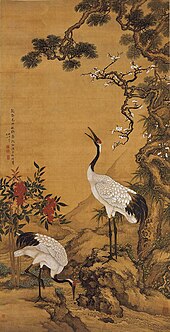
Under the Qing, inherited forms of art flourished and innovations occurred at many levels and in many types. High levels of literacy, a successful publishing industry, prosperous cities, and the Confucian emphasis on cultivation all fed a lively and creative set of cultural fields.
By the end of the nineteenth century, national artistic and cultural worlds had begun to come to terms with the cosmopolitan culture of the West and Japan. The decision to stay within old forms or welcome Western models was now a conscious choice. Classically trained Confucian scholars such as Liang Qichao and Wang Guowei read widely and broke aesthetic and critical ground later cultivated in the New Culture Movement.
Fine arts
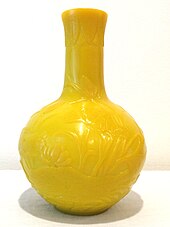
The Qing emperors were generally adept at poetry and often skilled in painting, and offered their patronage to Confucian culture. The Kangxi and Qianlong Emperors, for instance, embraced Chinese traditions both to control them and to proclaim their own legitimacy. The Kangxi Emperor sponsored the
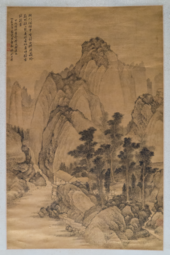
Yet the most impressive aesthetic works were done among the scholars and urban elite.
Traditional learning and literature
Traditional learning flourished, especially among Ming loyalists such as Dai Zhen and Gu Yanwu, but scholars in the school of evidential learning made innovations in skeptical textual scholarship. Scholar-bureaucrats, including Lin Zexu and Wei Yuan, developed a school of practical statecraft which rooted bureaucratic reform and restructuring in classical philosophy.
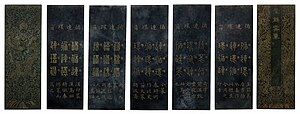
Philosophy[201] and literature grew to new heights in the Qing period. Poetry continued as a mark of the cultivated gentleman, but women wrote in larger numbers and poets came from all walks of life. The poetry of the Qing dynasty is a lively field of research, being studied (along with the poetry of the Ming dynasty) for its association with Chinese opera, developmental trends of Classical Chinese poetry, the transition to a greater role for vernacular language, and for poetry by women. The Qing dynasty was a period of literary editing and criticism, and many of the modern popular versions of Classical Chinese poems were transmitted through Qing dynasty anthologies, such as the Complete Tang Poems and the Three Hundred Tang Poems. Although fiction did not have the prestige of poetry, novels flourished. Pu Songling brought the short story to a new level in his Strange Tales from a Chinese Studio, published in the mid-18th century, and Shen Fu demonstrated the charm of the informal memoir in Six Chapters of a Floating Life, written in the early 19th century but published only in 1877. The art of the novel reached a pinnacle in Cao Xueqin's Dream of the Red Chamber, but its combination of social commentary and psychological insight were echoed in highly skilled novels such as Wu Jingzi's The Scholars (1750) and Li Ruzhen's Flowers in the Mirror (1827).[202]
Cuisine
See also
- Anti-Qing sentiment
- Mandarin square Costumes of Qing officials
- Foreign relations of the Qing dynasty
- Imperial Chinese harem system
- International relations (1814–1919)
- Islam during the Qing dynasty
- Legacy of the Qing dynasty
- List of diplomatic missions of the Qing dynasty
- List of emperors of the Qing dynasty
- List of rebellions in China
- List of recipients of tribute from China
- List of Chinese monarchs
- Manchuria under Qing rule
- Military history of China before 1912
- Mongolia under Qing rule
- Qing emperors' family tree
- Qing dynasty in Inner Asia
- Qing official headwear
- The Rise and Fall of Qing Dynasty
- Royal and noble ranks of the Qing dynasty
- Taiwan under Qing rule
- Tibet under Qing rule
- Timeline of Chinese history
- Timeline of late anti-Qing rebellions
- Xinjiang under Qing rule
Notes
- ^ Chinese: 盛京; pinyin: Shèngjīng; Manchu: ᠮᡠᡴ᠋ᡩᡝᠨ, Möllendorff: Mukden, Abkai: Mukden; capital after 1625 for Later Jin, secondary capital after 1644.
- ^ Manchu: ᠪᡝᡤᡳᠩ, Möllendorff: Beging, Abkai: Beging; primary capital afterwards
- ^ Briefly a constitutional monarchy following the onset of the Xinhai Revolution in 1911.
- ^ For other names, see Names of the Qing dynasty.
- ^ Although there were several attempts to restore the dynastic Chinese monarchy after the collapse of the Qing dynasty in 1912, such as the Empire of China (1915–1916), the Manchu Restoration (1917), and the Manchukuo (1932–1945), these are usually not recognised as politically legitimate regimes in Chinese historiography.
- ^ Dulimbai means 'central' or 'middle', gurun means 'nation' or 'state'
- ^ Chinese: 六部; pinyin: lìubù
- ^ traditional Chinese: 尚書; simplified Chinese: 尚书; pinyin: shàngshū; Manchu: ᠠᠯᡳᡥᠠ
ᠠᠮᠪᠠᠨ, Möllendorff: aliha amban, Abkai: aliha amban - ^ Chinese: 侍郎; pinyin: shìláng; Manchu: ᠠᠰᡥᠠᠨ ᡳ
ᠠᠮᠪᠠᠨ, Möllendorff: ashan i amban, Abkai: ashan-i amban - ^ traditional Chinese: 內閣; simplified Chinese: 内阁; pinyin: nèigé; Manchu: ᡩᠣᡵᡤᡳ
ᠶᠠᠮᡠᠨ, Möllendorff: dorgi yamun, Abkai: dorgi yamun - ^ traditional Chinese: 軍機處; simplified Chinese: 军机处; pinyin: jūnjī chù; Manchu: ᠴᠣᡠ᠋ᡥᠠᡳ
ᠨᠠᠰᡥᡡᠨ ᡳ
ᠪᠠ, Möllendorff: coohai nashūn i ba, Abkai: qouhai nashvn-i ba - ^ traditional Chinese: 軍機大臣; simplified Chinese: 军机大臣; pinyin: jūnjī dàchén
- ^ Chinese: 包衣; pinyin: bāoyī; Manchu: ᠪᠣᡠ᠋ᡳ, Möllendorff: booi, Abkai: boui
References
Citations
- ^ a b Rowe (2009), pp. 292.
- ^ a b "Ritual Music in the Court and Rulership of the Qing Dynasty (1644–1911)" (p. 136): "[1636] was the start of the Qing dynasty, although historians usually date the Qing dynasty started in 1644 when the Manchus conquered Beijing and north China."
- ^ Söderblom Saarela (2021).
- ^ Norman (1988), pp. 133–134.
- ^ "Living in the Chinese Cosmos: Understanding Religion in Late Imperial China (1644–1911)", What is Popular Religion, Columbia University, archived from the original on 19 January 2015, retrieved 15 June 2021
- ^ (PDF) from the original on 7 July 2020. Retrieved 24 July 2020.
- ISBN 9787552632859.)
{{cite book}}: CS1 maint: multiple names: authors list (link - ISBN 978-1788317894.
- ^ "Qing (Manchu) dynasty (1644-1912)". Facts and Details. August 2021. Retrieved 18 September 2023.
- ^ "Qing dynasty (1644–1911)". Smithsonian's National Museum of Asian Art. Retrieved 18 September 2023.
- ^ Hearn, Maxwell K. (October 2003). "The Qing Dynasty (1644–1911): Painting". The Metropolitan Museum of Art. Retrieved 18 September 2023.
- ISBN 9781108424615. Retrieved 18 September 2023.
- ^ "Qing Dynasty (1644–1911)". 16 May 2011. Retrieved 18 September 2023.
- ^ Marshall Broomhall (1907). The Chinese Empire: A General and Missionary Survey, Volumes 678-679. Morgan at Scott. pp. 2–3.
- ^ a b The Cambridge History of China: Volume 9, The Ch'ing Empire to 1800, Part 1, by Willard J. Peterson, p. 29
- ^ Rowe (2009), pp. 14–15.
- ^ "Kang Hsi Emperor". Retrieved 23 February 2024.
- ^ Deng, Kent (2015). China's Population Expansion and Its Causes during the Qing Period, 1644–1911 (PDF). p. 1. Retrieved 22 March 2024.
- ISBN 978-0812239126.
- ^ Crossley (1997), pp. 212–213.
- ISBN 978-9004418929. Archivedfrom the original on 8 May 2021. Retrieved 14 March 2021.
- ISBN 9780642278760
- ^ Zhao (2006), pp. 4, 7–10, 12–14 and 24 n. 4.
- .
- ^ Zhao (2006), pp. 4, 7–10, 12–14.
- ^ ISBN 978-1134362226.
- ^ "Qing dynasty". Encyclopedia Britannica. Archived from the original on 9 March 2018. Retrieved 15 February 2018.
- ^ Ebrey (2010), p. 220.
- ^ Crossley (1997), p. 3.
- ^ Ebrey & Walthall (2013), p. 271.
- ^ Wakeman (1985), p. 24.
- ISBN 978-1134462094. Archivedfrom the original on 11 March 2021. Retrieved 19 November 2020.
- ISBN 978-0500771471. Archivedfrom the original on 11 March 2021. Retrieved 19 November 2020.
- ^ a b Ebrey (2010), pp. 220–224.
- ^ Bernard Hung-Kay Luk, Amir Harrak-Contacts between cultures, Vol. 4, p. 25
- ^ Rawski (1991), p. 177.
- ^ Tumen jalafun jecen akū: Manchu studies in honour of Giovanni Stary By Giovanni Stary, Alessandra Pozzi, Juha Antero Janhunen, Michael Weiers
- ^ Li (2002), pp. 60–62.
- ^ Li (2002), p. 65.
- ^ "China". Encyclopedia Britannica. Archived from the original on 27 July 2019. Retrieved 21 July 2019.
- ^ The exact figure of Li Zicheng's forces at the battle of Shanhai Pass is disputed. Some primary sources, such as the official Qing and Ming court histories (《清世祖實錄》,《明史》), cite 200,000.
- ^ Spence (2012), p. 32.
- ^ Di Cosmo (2007), p. 6.
- ^ Naquin & Rawski (1987), p. 141.
- ^ Di Cosmo (2007), p. 23.
- ^ Di Cosmo (2007), p. 9.
- ^ Rawski (1991), p. 175.
- ^ Di Cosmo (2007), p. 7.
- ^ Spence (1990), p. 41.
- ^ Wakeman (1985), p. 478.
- ^ a b Spence (2012), p. 38.
- ^ Wakeman (1985), pp. 646–650.
- ^ Wakeman (1985), p. 648, n. 183.
- ^ Wakeman (1985), pp. 651–680.
- ^ Faure (2007), p. 164.
- ^ Ebrey (1993), p. [page needed].
- ^ Wakeman (1977), p. 83.
- JesuitMartin Martinius in his account Bellum Tartaricum with original text in Latin, first published in Rome 1654. First English edition, London: John Crook, 1654.
- ^ Ho (2011), p. 135.
- ^ Ho (2011), p. 198.
- ^ Ho (2011), p. 206.
- ^ Ho (2011), p. 307.
- ^ Rowe (2009), pp. 32–33.
- ^ Kuzmin, Sergius L.; Dmitriev, Sergey (2015). "Conquest dynasties of China or foreign empires? The problem of relations between China, Yuan and Qing". International Journal of Central Asian Studies. 19: 59–92. Archived from the original on 4 November 2021. Retrieved 14 November 2017 – via Academia.
- ^ "Treaty between Tibet and Nepal, 1856 (translation)" (PDF).
- ISBN 9788120810679.
- ISBN 9781134362226.
- ^ Alexander Golikov, Translating through the Cultural Barriers: the Qing Imperial Multilingualism[permanent dead link]
- . Retrieved 17 September 2023.
- JSTOR 2718931.
- ISBN 9780861718061.
- ^ Spence (2012), pp. 48–51.
- ^ Perdue (2005).
- ^ Spence (2012), pp. 62–66.
- ^ Spence (2012), pp. 97, 101.
- ^ Spence (2012), p. 72.
- ^ Hsü (1990), p. 35.
- ^ Rowe (2009), p. 68.
- ^ Hsü (1990), pp. 35–37.
- ^ Spence (2012), pp. 80–83.
- ^ Spence (2012), pp. 83, 86.
- ^ "康乾盛世"的文化專制與文字獄". china.com (in Chinese). Archived from the original on 5 January 2009. Retrieved 30 December 2008.
- ^ Schoppa, R. Keith. Revolution and its Past: Identities and Change in Modern Chinese History. Pearson Hall, 2010, pp. 42–43.
- ^ Spence (1990), pp. 112, 114, 116.
- ^ Têng & Fairbank (1954), p. 19.
- ^ "Taiping Rebellion | Causes, Effects, & Facts". Encyclopedia Britannica. Archived from the original on 3 May 2015. Retrieved 7 November 2021.
- ^ Platt (2012), p. xxii.
- ^ Hevia (2003).
- ^ Wright (1957), pp. 196–221.
- ^ Hsü (1990), pp. 328–330.
- ^ "California on the Amur, or the 'Zheltuga Republic' in Manchuria (1883–86)". Retrieved 9 September 2023.
- ISBN 9783737007085.
- ^ Crossley (2010), p. 117.
- ^ Reynolds (1993), pp. 35–36.
- ^ Spence (2012), pp. 223–225.
- ^ Reynolds (1993), pp. 5–11.
- ^ Hsü (1990), pp. 412–416.
- ^ Rhoads (2000), p. 121 ff.
- ^ Chien-nung Li, Jiannong Li, Ssŭ-yü Têng, "The political history of China, 1840–1928", p. 234
- ^ Billingsley (1988), pp. 56–59.
- ^ Spence (2012), p. 39.
- ^ Jackson & Hugus (1999), pp. 134–135.
- ^ Rowe (2009), pp. 211.
- ISBN 978-1-134-36620-0.
- ^ Bartlett (1991).
- ^ "The Rise of the Manchus". University of Maryland. Archived from the original on 18 December 2008. Retrieved 19 October 2008.
- ^ a b Rawski (1998), p. 179.
- ^ Rawski (1998), pp. 179–180.
- ^ Torbert (1977), p. 27.
- ^ Torbert (1977), p. 28.
- OL 6931635M. pp. 247, 620.
- ^ "Treaty of Peace between China and Japan (Treaty of Shimonoseki)". Ch'ing Dynasty Treaties and Agreements Preserved by the Ministry of Foreign Affairs of the Republic of China (Taiwan). National Palace Museum. 17 April 1895. 中國將管理下開地方之權並將該地方所有堡壘軍器工廠及一切屬公物件永遠讓於日本...台湾全岛及所有附属各岛屿...澎湖列岛 [China shall yield to Japan in perpetuity the rights to administer the following regions as well as all fortresses, munition factories, and public properties thereof ... the entire island of Taiwan and all appertaining islands ... Penghu archipelago]
- ^ Millward (2007), p. 190.
- ^ "<untitled>" (PDF). The New York Times. 19 January 1906. Archived (PDF) from the original on 26 March 2020. Retrieved 13 June 2018.
- ^ . 1906 – via Wikisource.
- ^ Rowe (2009), p. 91.
- ^ Rowe (2009), pp. 91–92.
- ^ a b Rowe (2009), p. 92.
- from the original on 8 November 2021. Retrieved 8 November 2021.
- ISBN 978-0-520-23075-0. Archivedfrom the original on 10 May 2016. Retrieved 11 July 2015.
- ISBN 978-0-674-54775-9.
- ^ "China's narrative of Han expansion". South China Morning Post. 2012. Archived from the original on 8 November 2021. Retrieved 8 November 2021.
- ISBN 978-0-7748-3655-5. Archivedfrom the original on 8 November 2021. Retrieved 8 November 2021.
- ISBN 978-1-4985-3705-6. Archivedfrom the original on 2 October 2022. Retrieved 8 August 2022.
- ^ Rowe (2002), p. 485.
- ^ Naquin & Rawski (1987), p. 117.
- ^ a b c d e Rowe (2009), p. [page needed].
- ^ Rowe (2009), pp. 109–110.
- ^ Rowe (2009), pp. 112–113.
- ^ Rowe (2009), p. 111.
- ^ Rowe (2009), pp. 114–116.
- ^ Sneath (2007), p. 101.
- ^ Xu Xiaoman (2005), p. 335.
- ^ Rowe (2009), pp. 116–117.
- ^ a b c d e f g Porter (2016), p. [page needed].
- ^ Sneath (2007), p. 98.
- ^ Sneath (2007), pp. 105–106.
- ^ Goossaert & Palmer (2011), p. 3.
- ^ "Living in the Chinese Cosmos: Understanding Religion in Late Imperial China (1644–1911)", Religion, the State, and Imperial Legitimacy, Columbia University, archived from the original on 12 April 2021, retrieved 15 June 2021
- ^ Teiser, Stephen F. (1996). "Introduction" (PDF). In Lopez, Donald S. Jr. (ed.). The Spirits of Chinese Religion. Princeton, NJ: Princeton University Press. p. 27. Archived (PDF) from the original on 24 August 2015. Retrieved 15 June 2021.
- ISBN 0340741333..
- ^ Elliott (2001), pp. 235, 241.
- ^ Rawski (1998), pp. 231–236, 242–243.
- ^ Rawski (1998), p. 236.
- ^ Elliott (2001), pp. 237–238.
- ^ Richard J. Smith (2007). Settling the Dead: Funerals, Memorials and Beliefs Concerning the Afterlife Archived 27 September 2011 at the Wayback Machine. Living in the Chinese Cosmos: Understanding Religion in Late-Imperial China
- ^ "Living in the Chinese Cosmos: Understanding Religion in Late Imperial China (1644–1911)" (Columbia University) Institutional Religion: The Three Teachings Archived 8 May 2017 at the Wayback Machine
- ^ Lagerwey (2010), pp. 6–7.
- ISBN 0674445155. Archivedfrom the original on 6 April 2017. Retrieved 15 June 2021., pp. 958–961.
- ^ Bays (2012), pp. 21–23.
- ^ Bays (2012), pp. 25–26.
- ^ a b c Reilly (2004), p. 43.
- ^ Reilly (2004), p. 44.
- ^ Elliott (2001), p. 241.
- ^ Daily (2013), p. 1.
- ^ Daily (2013), p. 145.
- ^ Daily (2013), pp. 188–189.
- ^ Reilly (2004), pp. 61, 64.
- ^ Reilly (2004), p. 48.
- ^ Reilly (2004), p. 49.
- ^ Reilly (2004), p. 50.
- ^ Reilly (2004), p. 52.
- ^ Reilly (2004), pp. 57, 62.
- ^ Goossaert & Palmer (2011), pp. 38–39.
- ISBN 978-0674018280, archivedfrom the original on 14 February 2022, retrieved 16 June 2021.
- ^ Goossaert & Palmer (2011), pp. 38–40.
- ^ Goossaert & Palmer (2011), pp. 40–41.
- ^ Mühlhahn (2019), p. 170.
- ^ Gerald H. Choa (1990). 'Heal the Sick' was Their Motto: The Protestant Medical Missionaries in China. Chinese University Press.
- S2CID 34206810.
- ^ Myers & Wang (2002), pp. 564, 566.
- ^ Myers & Wang (2002), p. 564.
- ^ a b Murphey (2007), p. 151.
- ^ Myers & Wang (2002), p. 593.
- ^ Myers & Wang (2002), pp. 593, 595.
- ^ Myers & Wang (2002), p. 598.
- ^ Myers & Wang (2002), pp. 572–573, 599–600.
- ^ Myers & Wang (2002), pp. 606, 609.
- ^ Xu, Suming (2005), "人学史观视阈下的中西大分流——对"为什么江南不是英国"之新思考 (The Great Divergence from a humanist perspective: Why was Jiangnan not England?)", Tianjin Social Science (in Chinese), 6
- ISBN 978-7-204-04420-7
- ^ Myers & Wang (2002), p. 587.
- ^ Myers & Wang (2002), pp. 587, 590.
- ISBN 978-0-7607-0687-9.
- ^ Twitchett & Fairbank (1978), p. 61.
- ^ Twitchett & Fairbank (1978), pp. 61–62.
- S2CID 225162563– via JSTOR.
- ^ a b Twitchett & Fairbank (1978), pp. 63–66.
- ISBN 978-1108995955.
- ^ Porter (2016), pp. 229–238.
- ^ Porter (2016), pp. 237–238.
- S2CID 202928323.
- ISBN 978-0801880896. Archivedfrom the original on 30 June 2020. Retrieved 10 September 2019.
- ISBN 978-0674016859.
- ^ "Recording the Grandeur of the Qing". The Metropolitan Museum of Art | Columbia University. Archived from the original on 20 December 2012. Retrieved 17 May 2020. Chinese painting
- ^ Boda, Yang. Study of glass wares from the Qing Dynasty (1644–1911). 1983.
- ^ Nilsson, Jan-Erik. "Chinese Porcelain Glossary: Glass, Chinese (Peking Glass)". gotheborg.com. Archived from the original on 14 February 2022. Retrieved 7 June 2017.
- ISBN 978-0-948723-71-1.
- ^ "Ch'ing Dynasty – The Art of Asia – Chinese Dynasty Guide". www.artsmia.org. Archived from the original on 27 September 2012. Retrieved 13 September 2012.
- ^ "Qing Dynasty, Painting". The Met. Metropolitan Museum of Art. Archived from the original on 20 September 2012. Retrieved 13 September 2012.
- ^ "Home". The Lingnan School of Painting. Archived from the original on 8 July 2012.
- ^ Ng, On-cho (2019). "Qing Philosophy". In Zalta, Edward N. (ed.). The Stanford Encyclopedia of Philosophy (Summer 2019 ed.). Metaphysics Research Lab, Stanford University. Archived from the original on 16 June 2020. Retrieved 18 January 2020.
- ^ "Ming and Qing Novels" (PDF). Berkshire Encyclopedia. Archived from the original (PDF) on 17 June 2013. Retrieved 13 September 2012.
- ^ Spence, Jonathan (1977). ""Ch'ing"". In Kwang-chih Chang (ed.). Food in Chinese Culture: Anthropological and Historical Perspectives. New Haven: Yale University Press. pp. 260–294.
Reprinted in Spence, Jonathan (1992). Chinese Roundabout: Essays in History and Culture. New York: W. W. Norton. - ^ Yuan Mei (5 September 2014). "Things to Avoid 12: Cliché (戒落套)". The Way of the Eating, Sean JS Chen, translator (Translating the Suiyuan Shidan). Archived from the original on 2 April 2015. Retrieved 7 June 2015.
Sources
- Bartlett, Beatrice S. (1991). Monarchs and Ministers: The Grand Council in Mid-Ch'ing China, 1723–1820. University of California Press. ISBN 978-0-520-06591-8.
- ISBN 978-1405159548.
- Billingsley, Phil (1988). Bandits in Republican China. Stanford, CA: Stanford University Press. ISBN 978-0-804-71406-8. Archivedfrom the original on 12 January 2021. Retrieved 18 May 2020.
- Crossley, Pamela Kyle (1997). The Manchus. Wiley. ISBN 978-1-55786-560-1.
- —— (2010). The Wobbling Pivot: China since 1800. Malden, MA: Wiley-Blackwell. ISBN 978-1-4051-6079-7.
- Daily, Christopher A. (2013). Robert Morrison and the Protestant Plan for China. Hong Kong: Hong Kong University Press. ISBN 978-9888208036.
- Di Cosmo, Nicola, ed. (2007). The Diary of a Manchu Soldier in Seventeenth Century China: "My Service in the Army," by Dzengseo. Routledge. ISBN 978-1-135-78955-8. Archivedfrom the original on 12 January 2021. Retrieved 12 July 2015.
- Ebrey, Patricia (1993). Chinese Civilization: A Sourcebook (2nd ed.). New York: Simon and Schuster. ISBN 978-0-02-908752-7.
- —— (2010). The Cambridge Illustrated History of China. Cambridge University Press. ISBN 978-0-521-12433-1.
- ——; Walthall, Anne (2013). East Asia: A Cultural, Social, and Political History (3rd ed.). Cengage Learning. ISBN 978-1-285-52867-0. Retrieved 1 September 2015.
- Elliott, Mark C. (2000). "The Limits of Tartary: Manchuria in Imperial and National Geographies" (PDF). (PDF) from the original on 17 December 2016. Retrieved 29 October 2013.
- —— (2001b), "The Manchu-language Archives of the Qing Dynasty and the Origins of the Palace Memorial System", Late Imperial China, 22 (1): 1–70, S2CID 144117089, archived from the original on 2 October 2022, retrieved 15 April 2022 Available at Digital Access to Scholarship at Harvard Here Archived 24 April 2022 at the Wayback Machine
- —— (2001). The Manchu Way: The Eight Banners and Ethnic Identity in Late Imperial China. Stanford University Press. ISBN 978-0-8047-4684-7. Archivedfrom the original on 1 August 2020. Retrieved 12 July 2015.
- Faure, David (2007). Emperor and Ancestor: State and Lineage in South China. Stanford University Press. ISBN 978-0-8047-5318-0.
- Goossaert, Vincent; Palmer, David A. (2011). The Religious Question in Modern China. Chicago: Chicago University Press. ISBN 978-0226304168. Archivedfrom the original on 29 July 2020. Retrieved 15 June 2021.
- Hevia, James L. (2003). English Lessons: The Pedagogy of Imperialism in Nineteenth-Century China. Durham & Hong Kong: Duke University Press & Hong Kong University Press. ISBN 978-0822331889.
- Ho, David Dahpon (2011). Sealords Live in Vain: Fujian and the Making of a Maritime Frontier in Seventeenth-Century China (Thesis). University of California, San Diego. Archived from the original on 29 June 2016. Retrieved 17 June 2016.
- Hsü, Immanuel C. Y. (1990). The rise of modern China (4th ed.). New York: Oxford University Press. ISBN 978-0-19-505867-3.
- Jackson, Beverly; Hugus, David (1999). Ladder to the Clouds: Intrigue and Tradition in Chinese Rank. Ten Speed Press. ISBN 978-1-580-08020-0.
- Lagerwey, John (2010). China: A Religious State. Hong Kong: Hong Kong University Press. ISBN 978-9888028047. Archivedfrom the original on 15 April 2021. Retrieved 15 June 2021.
- Li, Gertraude Roth (2002). "State building before 1644". In ISBN 978-0-521-24334-6.
- Liu, Kwang-Ching; Smith, Richard J. (1980). "The Military Challenge: The North-west and the Coast". In ISBN 978-0-521-22029-3.
- Millward, James A. (2007). Eurasian crossroads: a history of Xinjiang. Columbia University Press. ISBN 978-0-231-13924-3. Archivedfrom the original on 26 November 2015. Retrieved 18 May 2020.
- Mühlhahn, Klaus (2019). Making China Modern: From the Great Qing to Xi Jinping. Harvard University Press. pp. 21–227. ISBN 978-0-674-73735-8.
- Murphey, Rhoads (2007). East Asia: A New History (4th ed.). Pearson Longman. ISBN 978-0-321-42141-8.
- Myers, H. Ramon; Wang, Yeh-Chien (2002). "Economic developments, 1644–1800". In ISBN 978-0-521-24334-6.
- Naquin, Susan; Rawski, Evelyn Sakakida (1987). Chinese Society in the Eighteenth Century. Yale University Press. ISBN 978-0-300-04602-1. Archivedfrom the original on 31 August 2020. Retrieved 5 March 2018.
- Norman, Jerry (1988). Chinese. Cambridge; New York: Cambridge University Press. ISBN 0521228093.
- Perdue, Peter C. (2005). China Marches West: The Qing Conquest of Central Eurasia. Harvard University Press. ISBN 978-0-674-01684-2.
- Platt, Stephen R. (2012). Autumn in the Heavenly Kingdom: China, the West, and the Epic Story of the Taiping Civil War. Alfred A. Knopf. ISBN 978-0-307-27173-0.
- Porter, Jonathan (2016). Imperial China, 1350–1900. Lanham: Rowman & Littlefield. OCLC 920818520.
- ISBN 978-0-520-06930-5.
- —— (1998). The Last Emperors: A Social History of Qing Imperial Institutions. University of California Press. ISBN 978-0-520-21289-3.
- Reilly, Thomas H. (2004). The Taiping Heavenly Kingdom: Rebellion and the Blasphemy of Empire. Seattle: University of Washington Press. ISBN 978-0295801926.
- Rhoads, Edward J.M. (2000). Manchus & Han: Ethnic Relations and Political Power in Late Qing and Early Republican China, 1861–1928. Seattle: University of Washington Press. ISBN 0295979380. Archivedfrom the original on 14 February 2022. Retrieved 2 October 2021.
- Reynolds, Douglas Robertson (1993). China, 1898–1912 : The Xinzheng Revolution and Japan. Cambridge, MA: Council on East Asian Studies Harvard University : Distributed by Harvard University Press. ISBN 978-0-674-11660-3.
- ISBN 978-0-521-24334-6.
- —— (2009). China's Last Empire: The Great Qing. History of Imperial China. Cambridge, MA: Harvard University Press. ISBN 978-0-674-03612-3.
- Sneath, David (2007). The Headless State: Aristocratic Orders, Kinship Society, and Misrepresentations of Nomadic Inner Asia (illustrated ed.). Columbia University Press. ISBN 978-0-231-51167-4. Archivedfrom the original on 12 January 2021. Retrieved 4 May 2019.
- Söderblom Saarela, Mårten (2021). "Manchu Language". Oxford Research Encyclopedia of Asian History. Oxford University Press. ISBN 978-0-19-027772-7.
- —— (2012). The Search for Modern China (3rd ed.). New York: Norton. ISBN 978-0-393-93451-9.
- ISBN 978-0-674-12025-9.
- Torbert, Preston M. (1977). The Ch'ing Imperial Household Department: A Study of Its Organization and Principal Functions, 1662–1796. Harvard University Asia Center. ISBN 978-0-674-12761-6.
- Twitchett, Denis Crispin; Fairbank, John King (1978). The Cambridge history of China. Cambridge [England]: Cambridge University Press. OCLC 2424772.
- ISBN 978-0-02-933680-9. Archivedfrom the original on 19 August 2020. Retrieved 12 July 2015.
- —— (1985). The Great Enterprise: The Manchu Reconstruction of Imperial Order in Seventeenth-century China. Vol. I. University of California Press. ISBN 978-0-520-04804-1.
- Waley-Cohen, Joanna (2004). "The New Qing History". Radical History Review. 88 (1): 193–206. S2CID 144544216.
- Wang, Shuo (2008). "Qing Imperial Women: Empresses, Concubines, and Aisin Gioro Daughters". In Anne Walthall (ed.). Servants of the Dynasty: Palace Women in World History. University of California Press. ISBN 978-0-520-25444-2.
- Wright, Mary Clabaugh (1957). The Last Stand of Chinese Conservatism: The T'ung-Chih Restoration, 1862–1874. Stanford, CA: Stanford University Press. ISBN 978-0-804-70475-5.
- Xu Xiaoman (2005). ""Preserving the Bonds of Kin": Genealogy Masters and Genealogy Production in the Jiangsu-Zhejiang Area in the Qing and Republican Periods". In Brokaw, Cynthia J.; Chow, Kai-wing (eds.). Printing and Book Culture in Late Imperial China. Translated by Huang Yuanmei. Berkeley: University of California. ISBN 978-0520231269.
- Zhao, Gang (2006). "Reinventing China Imperial Qing Ideology and the Rise of Modern Chinese National Identity in the Early Twentieth Century" (PDF). Modern China. 32 (1): 3–30. S2CID 144587815. Archived from the original(PDF) on 25 March 2014.
Further reading
- Bickers, Robert (2011). The Scramble for China: Foreign Devils in the Qing Empire, 1832–1914. Penguin. ISBN 978-0-7139-9749-1.
- Crossley, Pamela Kyle (2000). A Translucent Mirror: History and Identity in Qing Imperial Ideology. University of California Press. ISBN 978-0-520-92884-8. Retrieved 20 March 2019.
- Crossley, Pamela Kyle; Siu, Helen F.; Sutton, Donald S. (2006). Empire at the Margins: Culture, Ethnicity, and Frontier in Early Modern China. University of California Press. ISBN 978-0-520-23015-6.
- Dunnell, Ruth W.; Elliott, Mark C.; Foret, Philippe; et al., eds. (2004). New Qing Imperial History: The Making of Inner Asian Empire at Qing Chengde. Routledge. ISBN 978-1-134-36222-6.
- Esherick, Joseph; Kayalı, Hasan; Van Young, Eric, eds. (2006). Empire to Nation: Historical Perspectives on the Making of the Modern World. Rowman & Littlefield. ISBN 978-0-7425-4031-6.
- Graff, David Andrew; Higham, Robin, eds. (2012). A Military History of China. University Press of Kentucky. ISBN 978-0-8131-3584-7. Archivedfrom the original on 12 January 2021. Retrieved 14 November 2015.
- ISBN 978-0-521-22029-3.
- Morse, Hosea Ballou. The international relations of the Chinese empire
- Owen, Stephen (1997). "The Qing Dynasty: Period Introduction" (PDF). In Owen, Stephen (ed.). An Anthology of Chinese Literature: Beginnings to 1911. New York: W. W. Norton. pp. 909–914. Archived(PDF) from the original on 3 March 2016.
- Paludan, Ann (1998). Chronicle of the Chinese Emperors. London: Thames & Hudson. ISBN 978-0-500-05090-3.
- ISBN 978-0-521-24334-6.
- Platt, Stephen R. (2018). Imperial Twilight: The Opium War and the End of China's Last Golden Age. New York: Vintage Books. ISBN 978-0345803023.
- Schorkowitz, Dittmar; Chia, Ning, eds. (2016). Managing Frontiers in Qing China: The Lifanyuan and Libu Revisited. Boston: Brill. ISBN 978-9004335004. Archivedfrom the original on 31 March 2022. Retrieved 31 March 2022.
- Smith, Richard Joseph (2015). The Qing Dynasty and Traditional Chinese Culture. Rowman and Littlefield. ISBN 978-1-4422-2193-2.
- Stanford, Edward (1917). Atlas of the Chinese Empire, containing separate maps of the eighteen provinces of China (2nd ed.). Legible color maps.
- Struve, Lynn A. (2004). The Qing Formation in World-Historical Time. Harvard University Asia Center. ISBN 978-0-674-01399-5.
- Waley-Cohen, Joanna (2006). The culture of war in China: empire and the military under the Qing dynasty. I.B. Tauris. ISBN 978-1-84511-159-5.
- Zhao, Gang (2013). The Qing Opening to the Ocean: Chinese Maritime Policies, 1684–1757. University of Hawaii Press. ISBN 978-0-8248-3643-6.
Primary source collections and reference
- Brunnert, I. S.; Gagelstrom, V. V. (1912). Present Day Political Organization of China. Translated by Edward Eugene Moran. Shanghai: Kelly and Walsh. Lists bureaucratic structure and offices, with standard translations.
- ISBN 978-0190088019). 800 biographical articles on people who died 1644 to 1912. Vol 1 of 1943 edition Internet Archive; Vol 2 Internet Archive
- Leung, Edwin Pak-wah (1992). Historical dictionary of revolutionary China, 1839–1976. Bloomsbury Academic. ISBN 978-0313264573.
- Leung, Edwin Pak-wah (2002). Political Leaders of Modern China: A Biographical Dictionary.
- MacNair, Harley Farnsworth, ed. (1923). Modern Chinese History Selected Readings. Shanghai: Commercial Press. Starts in 1842.
- The China year book. 1914.
Historiography
- Cohen, Paul (1984). Discovering History in China: American Historical Writing on the Recent Chinese Past. New York, London: Columbia University Press. ISBN 023152546X. Reprinted with new Introduction, 2010. Chapters on: The problem with "China's response to the West" – Moving beyond "Tradition and modernity" – Imperialism: reality or myth? – Toward a China-centered history of China.
- Ho, Ping-Ti (1967). "The Significance of the Ch'ing Period in Chinese History". The Journal of Asian Studies. 26 (2): 189–195. S2CID 162396785.
- —— (1998). "In Defense of Sinicization: A Rebuttal of Evelyn Rawski's 'Reenvisioning the Qing'". The Journal of Asian Studies. 57 (1): 123–155. JSTOR 2659026.
- Hsieh, Winston (1975). Chinese Historiography on the Revolution of 1911: A Critical Survey and a Selected Bibliography. Stanford, CA: Hoover Institution Press, Stanford University. ISBN 0817933417. Still useful for discussion of issues, schools of interpretation, and published sources.
- ISBN 0521772346. Archivedfrom the original on 20 January 2021. Retrieved 26 July 2020.
- Newby, L.J. (2011). "China: Pax Manjurica". Journal for Eighteenth-Century Studies. 34 (4): 557–563. . Discusses developments in scholarship on 18th century history published after 2000.
- Rawski, Evelyn S. (1996). "Reenvisioning the Qing: The Significance of the Qing Period in Chinese History". The Journal of Asian Studies. 55 (4): 829–850. S2CID 162388379.
- Rawski, Evelyn S. (June 2016). "The Qing in Historiographical Dialogue". Late Imperial China. 37 (1): 1–4. S2CID 147825070.
- Sivin, Nathan (1988). "Science and medicine in imperial China – The state of the field". Journal of Asian Studies. 47 (1): 41–90. S2CID 26443679.
- Wu, Guo (May 2016). "New Qing History: Dispute, Dialog, and Influence". Chinese Historical Review. 23 (1): 47–69. S2CID 148110389. Covers the New Qing History approach that arose in the U.S. in the 1980s and the responses to it.
- Yu, George T. (1991). "The 1911 Revolution: Past, Present, and Future". Asian Survey. 31 (10): 895–904. JSTOR 2645062.
External links
- Section on the Ming and Qing dynasties of "China's Population: Readings and Maps."
- Collection: "Manchu, Qing Dynasty" from the University of Michigan Museum of Art
- Qing Dynasty resource Archived 24 November 2020 at the Wayback Machine at the Virginia Museum of Fine Arts


